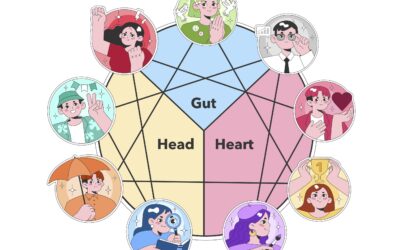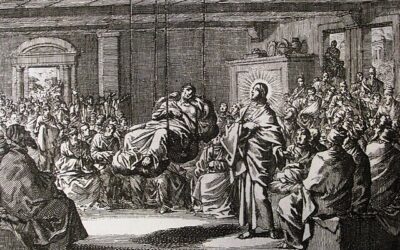The word “saint” has this refreshing thing going for it: It defines a person based on the best of who they are rather than the worst.
And who, I ask you, doesn’t want to be known for what we do right instead of what we do wrong? I, for one, like the ring of “Saint Anna” far better than “Sinner Anna.”
While I’m at it, I also prefer imagining myself with a halo over my head instead of horns. But that’s probably because, not so deep down, I know I’d have a far easier time listing my qualifications for the “sinner” designation than for the “saint” one.
Yet the sound of “Saint Anna” actually feels foreign to me. Awkward. Maybe a bit … pretentious. Perhaps even brazen. Quite possibly hollow.
“THIS OLD THING?”
Isn’t it interesting how we tend to identify ourselves readily by our failures, shortcomings and faults, be they moral, financial, personal, vocational or even avocational? We see this tendency surface even in subtle ways. For example, I know very few people, especially women, who can take a compliment with grace instead of with apologetic or demure protestations.
Compliment: “I love your dress!” Response: “What, this old thing?”
Compliment: “Great job!” Response: “Well, but really I did no more than anyone else.”
Compliment: “You’re a fantastic cook!” Response: “Oh, I’ve just made this dish forever!”
Some of this is gender-related stuff, of course: I’ve mentioned in Gather before the theologian Valerie Saiving Goldstein, who as a female grad student in theology in the ’60s wrote a blockbuster paper about sin. In it, she rejected the long-standing, still-often maintained notion that sin, in all its forms and expressions, stems from pride: Think “Pride goeth before a fall.” She argued that, sure, while pride might be the primary source of sin for men, for women sin instead tends to stem from humility. Pride surfaces in the form of a desire for power and a tendency toward violence, arrogance and a lack of concern for others. But these profiles in sin, said Saiving Goldstein, are evidenced more in men than in women.
In contrast, feminine sin shows forth in opposite ways, including lack of self-worth, passivity and difficulty pursuing a dream. So as women, with all the weight of past and present cultural and familial forces bearing down on us, we tend to be uncomfortable with seeing our gifts and stewarding them with confidence, let alone saying a robust “Thank you!” when we’re acknowledged for doing something well.
We might answer the compliment “You are amazing!” in the same way we do a compliment about that dress of ours: “What, this old thing?” We are humble to a fault. So our dis-ease with considering ourselves “Saint
So-and-so” rather than “Sinner So-and-so” is partly driven by external, and internalized, gender expectations, roles and ways.
But gender habits aren’t the only piece that might make women uncomfortable with the notion of themselves as saints. I’m convinced that a hefty number of Lutherans (yes, even cradle Lutherans) are of the mind that whatever horrible things we may have done or not done have more weight before the throne of God than does grace.
Despite all the Lutheran talk about grace, we still tend to think about scales and to consider our good deeds as pebbles and our bad ones as boulders.
We fear—and perhaps even believe—that our misdeeds are actually very much stacked against us.
AT THE SAME TIME
Martin Luther grasped this existential fear about sinfulness. He knew it in his bones. Ultimately, he wrestled with it, like Jacob with the angel.
Yet even though (or perhaps because?) the struggle bruised him, Luther morphed his fear into a theological revolution. We are sinful, he determined, and we are also bestowed with grace by which we as sinners are transformed into saints. He even came up with a Latin phrase for it, one that was so catchy that today you can easily find T-shirts and tattoos emblazoned with the words simul iustus et peccator.
We discover the phrase first used in Luther’s commentary on Paul’s letter to the Galatians (Luther’s Works 26:232), in his musings on Galatians 3:6–7. In this passage, Paul wrote: “Just as Abraham ‘believed God, and it was reckoned to him as righteousness,’ so, you see, those who believe are the descendants of Abraham.”
Luther (who loved Galatians so much he called it his “Katie von Bora”) said about this text, “Thus a Christian is righteous and a sinner at the same time [simul iustus et peccator], holy and profane, an enemy of God and a child of God. None of the sophists will admit this paradox, because they do not understand the true meaning of justification. …We, on the other hand, teach and comfort an afflicted sinner this way: ‘… it is impossible for you to become so righteous in this life that your body is as clear and spotless as the sun. You still have spots and wrinkles (Eph. 5:27), and yet you are holy.’”
All Saints Day is an occasion to recall that Luther was right (as was Paul, of course): We have spots, we have wrinkles…and we are holy. Simul iustus et peccator.
The Rev. Anna Madsen is a freelance theologian and proud mama to daughter Else and son Karl. She works with OMG: Center for Theological Conversation (omgcenter.com) and enjoys seeing the occasional moose and bear in their woods.
This article is excerpted from the November 2020 issue of Gather magazine. To read more like it, subscribe to Gather.
A priceless gift
In 1993, my husband and I moved from Southern California where I’d grown up to Berkeley, where I...
In the image of God
If you were to attend Sunday service at Holly Grove Lutheran Church in Lexington, North Carolina,...
Faith in economics
What is the rule of your household? How do you manage your home? How do you make sure that...





